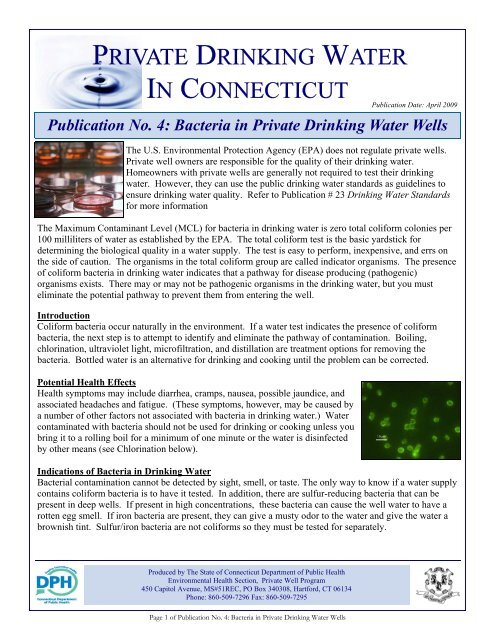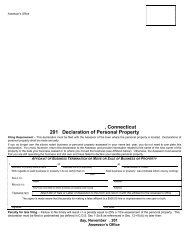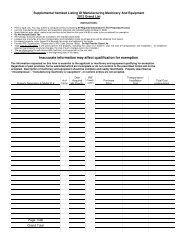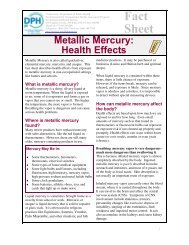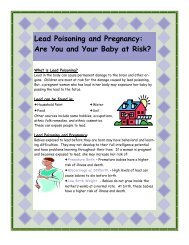#04 Bacteria in Private Drinking Water Wells 04-09 - CT.gov
#04 Bacteria in Private Drinking Water Wells 04-09 - CT.gov
#04 Bacteria in Private Drinking Water Wells 04-09 - CT.gov
- No tags were found...
You also want an ePaper? Increase the reach of your titles
YUMPU automatically turns print PDFs into web optimized ePapers that Google loves.
PRIVATEDRINKINGWATERIN CONNE<strong>CT</strong>ICUTPublication Date: April 20<strong>09</strong>Publication No. 4: <strong>Bacteria</strong> <strong>in</strong> <strong>Private</strong> Dr<strong>in</strong>k<strong>in</strong>g <strong>Water</strong> <strong>Wells</strong>The U.S. Environmental Protection Agency (EPA) does not regulate private wells.<strong>Private</strong> well owners are responsible for the quality of their dr<strong>in</strong>k<strong>in</strong>g water.Homeowners with private wells are generally not required to test their dr<strong>in</strong>k<strong>in</strong>gwater. However, they can use the public dr<strong>in</strong>k<strong>in</strong>g water standards as guidel<strong>in</strong>es toensure dr<strong>in</strong>k<strong>in</strong>g water quality. Refer to Publication # 23 Dr<strong>in</strong>k<strong>in</strong>g <strong>Water</strong> Standardsfor more <strong>in</strong>formationThe Maximum Contam<strong>in</strong>ant Level (MCL) for bacteria <strong>in</strong> dr<strong>in</strong>k<strong>in</strong>g water is zero total coliform colonies per100 milliliters of water as established by the EPA. The total coliform test is the basic yardstick fordeterm<strong>in</strong><strong>in</strong>g the biological quality <strong>in</strong> a water supply. The test is easy to perform, <strong>in</strong>expensive, and errs onthe side of caution. The organisms <strong>in</strong> the total coliform group are called <strong>in</strong>dicator organisms. The presenceof coliform bacteria <strong>in</strong> dr<strong>in</strong>k<strong>in</strong>g water <strong>in</strong>dicates that a pathway for disease produc<strong>in</strong>g (pathogenic)organisms exists. There may or may not be pathogenic organisms <strong>in</strong> the dr<strong>in</strong>k<strong>in</strong>g water, but you mustelim<strong>in</strong>ate the potential pathway to prevent them from enter<strong>in</strong>g the well.IntroductionColiform bacteria occur naturally <strong>in</strong> the environment. If a water test <strong>in</strong>dicates the presence of coliformbacteria, the next step is to attempt to identify and elim<strong>in</strong>ate the pathway of contam<strong>in</strong>ation. Boil<strong>in</strong>g,chlor<strong>in</strong>ation, ultraviolet light, microfiltration, and distillation are treatment options for remov<strong>in</strong>g thebacteria. Bottled water is an alternative for dr<strong>in</strong>k<strong>in</strong>g and cook<strong>in</strong>g until the problem can be corrected.Potential Health EffectsHealth symptoms may <strong>in</strong>clude diarrhea, cramps, nausea, possible jaundice, andassociated headaches and fatigue. (These symptoms, however, may be caused bya number of other factors not associated with bacteria <strong>in</strong> dr<strong>in</strong>k<strong>in</strong>g water.) <strong>Water</strong>contam<strong>in</strong>ated with bacteria should not be used for dr<strong>in</strong>k<strong>in</strong>g or cook<strong>in</strong>g unless youbr<strong>in</strong>g it to a roll<strong>in</strong>g boil for a m<strong>in</strong>imum of one m<strong>in</strong>ute or the water is dis<strong>in</strong>fectedby other means (see Chlor<strong>in</strong>ation below).Indications of <strong>Bacteria</strong> <strong>in</strong> Dr<strong>in</strong>k<strong>in</strong>g <strong>Water</strong><strong>Bacteria</strong>l contam<strong>in</strong>ation cannot be detected by sight, smell, or taste. The only way to know if a water supplyconta<strong>in</strong>s coliform bacteria is to have it tested. In addition, there are sulfur-reduc<strong>in</strong>g bacteria that can bepresent <strong>in</strong> deep wells. If present <strong>in</strong> high concentrations, these bacteria can cause the well water to have arotten egg smell. If iron bacteria are present, they can give a musty odor to the water and give the water abrownish t<strong>in</strong>t. Sulfur/iron bacteria are not coliforms so they must be tested for separately.Produced by The State of Connecticut Department of Public HealthEnvironmental Health Section, <strong>Private</strong> Well Program450 Capitol Avenue, MS#51REC, PO Box 340308, Hartford, <strong>CT</strong> 06134Phone: 860-5<strong>09</strong>-7296 Fax: 860-5<strong>09</strong>-7295Page 1 of Publication No. 4: <strong>Bacteria</strong> <strong>in</strong> <strong>Private</strong> Dr<strong>in</strong>k<strong>in</strong>g <strong>Water</strong> <strong>Wells</strong>
Test<strong>in</strong>g for <strong>Bacteria</strong> <strong>in</strong> <strong>Private</strong> Dr<strong>in</strong>k<strong>in</strong>g <strong>Water</strong> <strong>Wells</strong>The primary test to determ<strong>in</strong>e the presence of bacteria is the total coliform test. Todeterm<strong>in</strong>e if bacteria are present, arrange to test your dr<strong>in</strong>k<strong>in</strong>g water at a state certifiedlaboratory. Follow laboratory <strong>in</strong>structions carefully to avoid contam<strong>in</strong>ation and obta<strong>in</strong> agood sample. Before collect<strong>in</strong>g the sample; flush the pressure tank, by-pass all treatment,and remove the faucet aerator. Run the cold water for several m<strong>in</strong>utes and then collect yoursample. Test your well water for bacteria under the follow<strong>in</strong>g conditions:• At least annually (preferably semi-annually, spr<strong>in</strong>g/fall).• When a new well is constructed.• When an exist<strong>in</strong>g well is returned to service. If the home has been unoccupied for a while, flush thewater storage tank and allow the water to run for about 20 m<strong>in</strong>utes with the faucet open fully beforecollect<strong>in</strong>g the sample.• Anytime a component of the water system is opened for repair. This <strong>in</strong>cludes the well, pump,pressure tank, pip<strong>in</strong>g, and any other components that your dr<strong>in</strong>k<strong>in</strong>g water comes <strong>in</strong>to contact.• Whenever flood waters or surface runoff <strong>in</strong>undates the well.• Whenever you suspect bacterial contam<strong>in</strong>ation, as might be <strong>in</strong>dicated by cont<strong>in</strong>u<strong>in</strong>g illness <strong>in</strong> thehouse.• When a state certified laboratory test <strong>in</strong>dicates nitrate concentrations above 10 milligrams per literor any other nitrogen components <strong>in</strong>crease and human or livestock waste is the suspected cause.Lend<strong>in</strong>g agencies often require at least a total coliform test for homes rely<strong>in</strong>g on private water suppliesbefore the sale of property or approv<strong>in</strong>g a new or ref<strong>in</strong>anced home loan.If <strong>Water</strong> Tests Indicate the Presence of Coliform <strong>Bacteria</strong>If a water test <strong>in</strong>dicates the presence of coliform bacteria, you should not dr<strong>in</strong>k the water oruse it for cook<strong>in</strong>g, brush<strong>in</strong>g teeth, etc. The next step is to attempt to identify and elim<strong>in</strong>ate thesource of contam<strong>in</strong>ation. If you are unable to locate and elim<strong>in</strong>ate the bacteria source andcannot afford a new well, you may need a long-term treatment method. Overall, long-termtreatment methods may result <strong>in</strong> be<strong>in</strong>g the most expensive alternative due to cont<strong>in</strong>uousoperation and ma<strong>in</strong>tenance costs.As you attempt to f<strong>in</strong>d the source of contam<strong>in</strong>ation, evaluate both well location and wellconstruction. Check the entire water distribution system for potential problem areas,<strong>in</strong>clud<strong>in</strong>g a garden hose without proper backflow prevention.Well location is a crucial safety factor. A well that is downhill from a source of bacterialcontam<strong>in</strong>ation runs a greater risk of contam<strong>in</strong>ation that a well on the uphill side of thepollution source. Good well location requires m<strong>in</strong>imum separation distances from sources ofpotential contam<strong>in</strong>ation, us<strong>in</strong>g the natural protection provided by soil filtration. Contact aregistered well driller or pump <strong>in</strong>staller for all well ma<strong>in</strong>tenance or repairs.Sources of <strong>Bacteria</strong> <strong>in</strong> Dr<strong>in</strong>k<strong>in</strong>g <strong>Water</strong>Most coliforms are harmless bacteria that are found <strong>in</strong> large numbers <strong>in</strong> the <strong>in</strong>test<strong>in</strong>es andfeces of warm-blooded animals and occur naturally <strong>in</strong> soil and vegetation. While most coliform bacteriaare not harmful, their presence <strong>in</strong>dicates the possible existence of pathogens <strong>in</strong> the water supply. Coliformbacteria should not be present <strong>in</strong> a properly constructed well. When look<strong>in</strong>g for potential pathways forcoliform <strong>in</strong>trusion, the follow<strong>in</strong>g sources should be <strong>in</strong>vestigated:Human Waste associated with malfunction<strong>in</strong>g septic systems and leak<strong>in</strong>g sewer pipes have been identifiedas a potential source of bacterial contam<strong>in</strong>ation to a dr<strong>in</strong>k<strong>in</strong>g water well. A septic system located too closePage 2 of Publication No. 4: <strong>Bacteria</strong> <strong>in</strong> <strong>Private</strong> Dr<strong>in</strong>k<strong>in</strong>g <strong>Water</strong> <strong>Wells</strong>
can physically trap bacteria as it moves and once over a distance of 75 feet, the bacteria will die <strong>in</strong>unsaturated soil conditions.Animal waste is a common source of bacteria <strong>in</strong> water. These sources of bacterial contam<strong>in</strong>ation <strong>in</strong>cluderunoff from feedlots, pastures, dog runs, and other land areas conta<strong>in</strong><strong>in</strong>g other animal wastes. <strong>Bacteria</strong> fromthese sources can enter wells that are open at the land surface, that lack water-tight cas<strong>in</strong>gs or caps that areshallow, or do not have a grout seal <strong>in</strong> the annular space (the space between the wall of a drilled well andthe outside of the well cas<strong>in</strong>g).Insects, rodents or other animals enter<strong>in</strong>g the well are also potential sources ofcontam<strong>in</strong>ation. Dug wells usually have large access open<strong>in</strong>gs and cas<strong>in</strong>gs that may not beproperly sealed. This makes it easy for <strong>in</strong>sects, rodents, or other animals to enter the well.Inundation or <strong>in</strong>filtration of the well by floodwaters and surface water runoff can result <strong>in</strong> high levels ofbacterial contam<strong>in</strong>ation to the water supply. Even small depressions around the wellhead that fill withsurface runoff provide an excellent breed<strong>in</strong>g ground for bacteria. <strong>Bacteria</strong> can easily enter your watersupply when the well is shallow and/or the well cas<strong>in</strong>g is not properly sealed and watertight. This isespecially a risk <strong>in</strong> sandy soils.Older wells and water sources, especially dug wells, spr<strong>in</strong>g-fed systems and cistern-typesystems are very vulnerable to coliform bacteria and other pathogenic contam<strong>in</strong>ants.Any systems with cas<strong>in</strong>gs or caps that are not watertight, or lack a grout seal <strong>in</strong> theannular space, are vulnerable. This is particularly true if the well is located wheresurface runoff can accumulate and enter the well. Dur<strong>in</strong>g the last five to ten years, welland water distribution system construction has improved to the po<strong>in</strong>t where bacterial contam<strong>in</strong>ation due topoor well construction is rare <strong>in</strong> newer wells.Corrective ActionThe immediate remedy is to dis<strong>in</strong>fect the well with chlor<strong>in</strong>e bleach; however, dis<strong>in</strong>fection may only be atemporary remedy. The most important consideration is to f<strong>in</strong>d and elim<strong>in</strong>ate the source of thecontam<strong>in</strong>ation. Most bacterial problems are caused by improper well construction and/or may have been<strong>in</strong>troduced dur<strong>in</strong>g well ma<strong>in</strong>tenance or repair. Faulty construction can often be corrected to fix theproblem. Some examples <strong>in</strong>clude:• Replac<strong>in</strong>g a leaky well cap or dug well cover• Repair<strong>in</strong>g a malfunction<strong>in</strong>g septic system• Divert<strong>in</strong>g surface water away from the well• Renovat<strong>in</strong>g/deepen<strong>in</strong>g the well• Drill<strong>in</strong>g another well to obta<strong>in</strong> a safe supply from a deeper level of groundwater• Remov<strong>in</strong>g livestock or pets from the well areaChlor<strong>in</strong>ationChlor<strong>in</strong>ation can be an effective method to kill bacteria. Chlor<strong>in</strong>ate when a well isnew, repaired, or contam<strong>in</strong>ated with bacteria. Use household chlor<strong>in</strong>e bleach thatdoes not have scents or other additives. Dis<strong>in</strong>fect the well as outl<strong>in</strong>ed below:- New well: 1.5 quarts of household chlor<strong>in</strong>e bleach per 100 feet of welldepth.- Exist<strong>in</strong>g well: 1 p<strong>in</strong>t of household chlor<strong>in</strong>e bleach (all well depths).1. Mix the appropriate amount of household chlor<strong>in</strong>e bleach with 5 gallons of water and pour <strong>in</strong> the wellthrough the top of the well cas<strong>in</strong>g.Page 3 of Publication No. 4: <strong>Bacteria</strong> <strong>in</strong> <strong>Private</strong> Dr<strong>in</strong>k<strong>in</strong>g <strong>Water</strong> <strong>Wells</strong>
2. Run the water at each and every (hot & cold) faucet, <strong>in</strong>clud<strong>in</strong>g the outdoor faucet, until achlor<strong>in</strong>e odor is detected. If no chlor<strong>in</strong>e odor is detected, repeat step 1 above until achlor<strong>in</strong>e odor is detected at each tap. If you have a refrigerator with an automatic icemakerand cold-water dispenser, you should also flush those until a chlor<strong>in</strong>e odor is noted.3. Close the faucets and allow the chlor<strong>in</strong>ated water to rema<strong>in</strong> <strong>in</strong> the well and pip<strong>in</strong>g systemfor at least 3 hours, preferably overnight.4. Run the water at each and every faucet until no chlor<strong>in</strong>e odor is detected. Flush every coldand hot water tanks as well to remove any oxidized sediments.5. Wait at least 24 hours after no chlor<strong>in</strong>e odor is detected before collect<strong>in</strong>g samples for analysisIf bacteriological problems persist follow<strong>in</strong>g chlor<strong>in</strong>ation, you have not successfully elim<strong>in</strong>ated the sourceof contam<strong>in</strong>ation.Chlor<strong>in</strong>ation, however, does have its limitations. Chlor<strong>in</strong>e solutions are only moderately stable, organicmatter as well as iron and manganese consumes chlor<strong>in</strong>e. High chlor<strong>in</strong>e concentrations have objectionabletastes and odors, and even low chlor<strong>in</strong>e concentrations may have objectionable tastes and odors for somepeople. Chlor<strong>in</strong>e use can also react with organic material to form trihalomethanes. Yet <strong>in</strong> spite of thesefactors, chlor<strong>in</strong>ation is widely used on small private water systems to ensure bacteriologically safe dr<strong>in</strong>k<strong>in</strong>gwater systems.Long-term Home <strong>Water</strong> TreatmentAll efforts should be made to identify and elim<strong>in</strong>ate the source of bacteria. If theproblem is due to a fail<strong>in</strong>g septic system, improper well ma<strong>in</strong>tenance, or proximity of thewell to animal pens, consider the costs of improv<strong>in</strong>g these situations over the long termversus long-term water treatment. If you cannot identify and correct the bacteria source,then there are home water treatment options available to you. These <strong>in</strong>clude ultravioletradiation, distillation, ozonation, and microfiltration. For more <strong>in</strong>formation on thesetreatment options, please see Publications:Publication #7 DistillationPublication #14 Microfiltration Treatment of Dr<strong>in</strong>k<strong>in</strong>g <strong>Water</strong> SystemsPublication #17 Ozone Treatment of <strong>Private</strong> Dr<strong>in</strong>k<strong>in</strong>g <strong>Water</strong> SystemsPublication #25 Ultraviolet Radiation Treatment of <strong>Private</strong> Dr<strong>in</strong>k<strong>in</strong>g <strong>Water</strong> SystemsRegardless of the quality of the equipment purchased, it will not operate unless ma<strong>in</strong>ta<strong>in</strong>ed <strong>in</strong> accordancewith the manufacturer’s recommendations. Keep a logbook to record equipment ma<strong>in</strong>tenance and repairs.Equipment ma<strong>in</strong>tenance may <strong>in</strong>clude periodic clean<strong>in</strong>g and replacement of some components. Alsoconsider any special <strong>in</strong>stallation requirements that may add to the equipment costs. For more <strong>in</strong>formation,refer to Publication #19 Questions to Ask When Purchas<strong>in</strong>g Home <strong>Water</strong> Treatment Equipment.Protection of <strong>Private</strong> Dr<strong>in</strong>k<strong>in</strong>g <strong>Water</strong> SuppliesYou can protect your private well by pay<strong>in</strong>g careful attention to what you do <strong>in</strong> and around your home aswell as your neighbor’s activities near your well. Regular test<strong>in</strong>g and adopt<strong>in</strong>g practices to preventcontam<strong>in</strong>ation can help ensure that your well supplies you and your family with good quality dr<strong>in</strong>k<strong>in</strong>gwater. For more <strong>in</strong>formation on well protection see Well Publication #26 <strong>Private</strong> Dr<strong>in</strong>k<strong>in</strong>g <strong>Water</strong> <strong>Wells</strong>.For more <strong>in</strong>formation please click on the follow<strong>in</strong>g l<strong>in</strong>ks:EPA Office of Groundwater and Dr<strong>in</strong>k<strong>in</strong>g <strong>Water</strong>http://www.epa.<strong>gov</strong>/ogwdw/EPA New Englandhttp://www.epa.<strong>gov</strong>/region01/Adapted from Healthy Dr<strong>in</strong>k<strong>in</strong>g <strong>Water</strong>s for Rhode Islanders, University of Rhode Island Cooperative Extension, April 2003.Page 4 of Publication No. 4: <strong>Bacteria</strong> <strong>in</strong> <strong>Private</strong> Dr<strong>in</strong>k<strong>in</strong>g <strong>Water</strong> <strong>Wells</strong>


